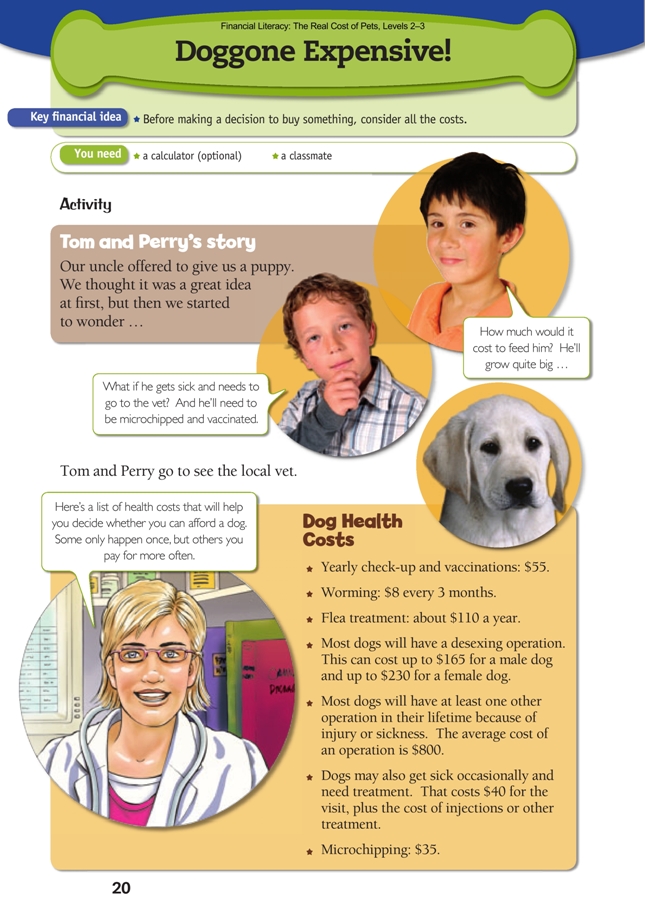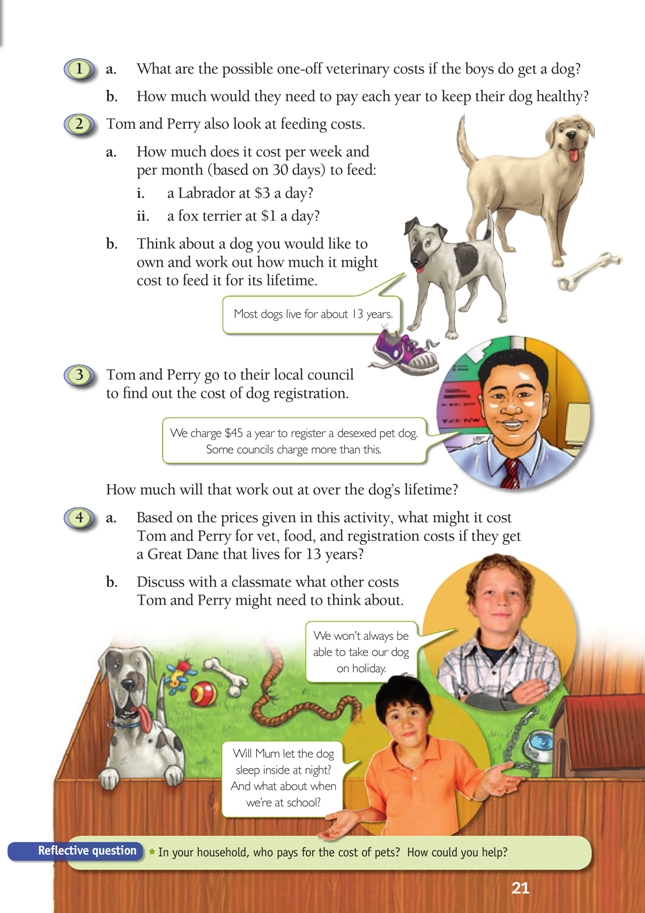This is a level 2 number and statistics activity and a level 3 algebra activity from the Figure It Out series. It relates to Stage 5 of the Number Framework.
A PDF of the student activity is included.
Click on the image to enlarge it. Click again to close. Download PDF (2086 KB)
use additive strategies to calculate costs
calculate costs by month and year/s
Number Framework Links
Students at stage 5 may need to use a calculator to do this work independently. Students at stage 6 should be able to use numeracy strategies to solve the problems in this activity, including written forms. (See the table of NDP material on page 4.)
A calculator (optional)
A classmate
Financial understanding
In this activity, Tom and Perry realise that they need to consider all the costs involved before they decide whether to take up their uncle’s offer of a puppy. They identify, assess, and investigate ways to manage the risks associated with owning a pet for 13 years. By doing this, they are being financially responsible in the decision
they make – regardless of whether it is for or against taking on the puppy.
Mathematics and statistics
For this activity, students need to know the number of days/weeks in a month and weeks/months in a year. You could introduce the activity by having a class discussion on giving animals as gifts. Ask What animals might be given as gifts? If you have a suitable experience, share it, for example, My grandfather offered to buy me a pony
when I was your age, but Mum and Dad said no. Why would they say that? Find out if anyone in the class has been given a pet and whether this caused any problems at home.
For question 2, students at stage 5 will need assistance to break down the numbers to be workable for them, using numeracy strategies. For example, $3 x 30 could be worked out as $3 multiplied by three lots of 10 ($3 x 3 x 10) or three lots of $3 x 10.
Further investigations: mathematics and statistics; social sciences
The students could:
• discuss whether it is cheaper to buy dog food in bulk or in smaller amounts. This gives stage 7 and 8 students an opportunity to begin ratio comparisons.
• compare supermarket-brand dog food with vet-quality food. Why do people choose to spend more on vet products, and how is this beneficial?
• discuss why in the past many pet cats and dogs were not fed bought food. How did they survive? Why has this changed?
• investigate how much it costs a zoo to keep an animal for a year. What costs would they have or not have compared to owners of pets living in homes?
• research which pets are more costly to look after in the holidays. Which ones can a neighbour care for, which ones need to go into care, which ones can you take with you?
• investigate the costs of kennels or catteries and why some people pay more than others for the care of their pets. What might they get in return for paying more?
Social Sciences Links
Achievement objectives:
• Understand how people make choices to meet their needs and wants (Social Studies, level 2)
• Understand how people make decisions about access to and use of resources (Social Studies, level 3)
The students could discuss what similar choices are investigated in their classroom and school about the full cost of an item or an activity before a decision is made. They could conduct a social inquiry within the school or the wider community about a resourcing issue, such as new sports equipment.
Other Cross-curricular Links
English achievement objective:
• Purposes and audiences: Show a developing understanding of how texts are shaped for different purposes and audiences (Listening, Reading, and Viewing, level 3)
The students could design an interview for a vet (but only carry out the interview if the vet is able and willing to spend the time involved). This could be expanded into a movie if there was a willing vet (or an adult prepared to act as the vet – the students would need to research the information needed). The movie could be produced as a documentary on what people need to do to care for a cat/dog and whether people
should give or get a pet as a present.
Technology achievement objective:
• Brief development: Describe the nature of an intended outcome, explaining how it addresses the need or opportunity. Describe the key attributes that enable development and evaluation of an outcome (Technological Practice, level 3)
The students could design a dog-exercising machine or a cat enclosure for a cattery.
Answers to Activity
1. a. Desexing ($165–$230) and microchipping ($35)
b. Approximately $197. (Annual check-up and vaccinations, worming, flea treatment, $55 + $32 + $110)
2. a. i. $21 per week and $90 (30 x $3 = $90) per month
ii. $7 per week and $30 (30 x $1 = $30) per month
b. Answers will vary depending on the size of the dog. For a Labrador, this might
be approximately $14,235 ($3 x 365 days x 13 years) and for a fox terrier, approximately $4,745 ($1 x 365 days x 13 years).
3. Answers may vary, for example, $585, based on the dog living for 13 years and the price staying at $45.
4. a. Answers will vary, depending on operations and other vet bills (for example, pills) and how the dog is fed. (For example, vet costs from page 20: [$55 x 13] + [$32 x 13] + [$110 x 13] + $230 [female dog desexing] + $800 + 5 visits at $40 + $35 = $3,826; $585 registration; $14,235 food: a total of $18,646)
b. Answers will vary. There will be set-up costs, possibly kennel costs if the family
goes on holiday, and non-money costs such as the time needed for exercising the dog.
Reflective question
Answers will vary. Helping needn’t be just a case of money. You might offer to do an extra chore as a way of saying thank you.

